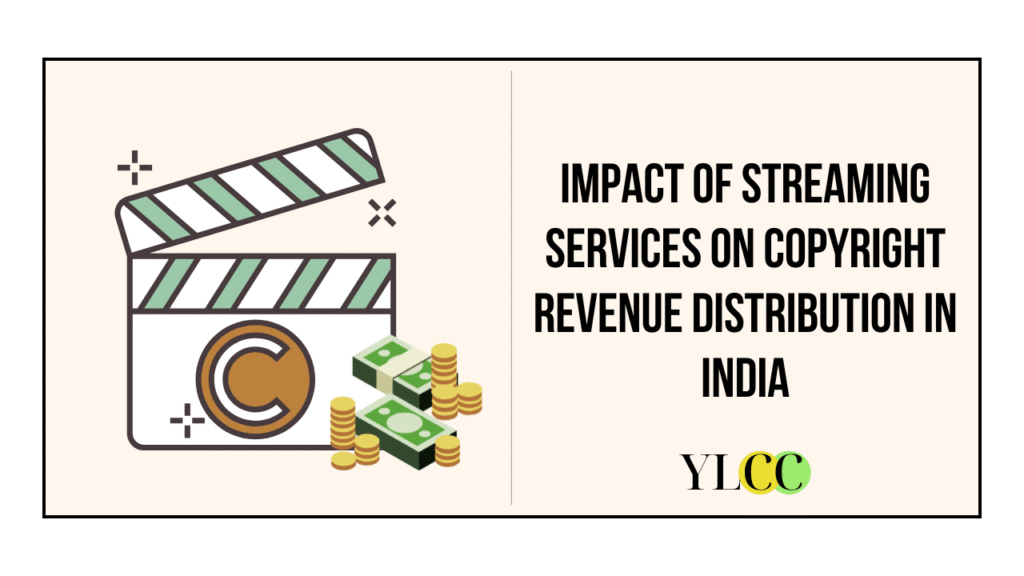
ABSTRACT:-
In recent years, India has undergone a revolutionary change in content consumption patterns due to the availability of different streaming giants like Netflix, Amazon Prime, Disney+ Hotstar, Spotify, Jio Saavn, etc. These have changed how content is consumed, delivering entertainment in different forms and various languages at people’s convenience. The Over-the-Top (OTT) market in India was approximately INR 249.09 billion in FY 2022 and is expected to grow at the rate of INR 581.21 billion by FY 2027 with a CAGR of 16.58%.
Copyright revenue is the income received from the protection of ownership rights of original works and inventions originated with their creators, artists, or other rightful owners. This comprises licensing, streaming, public performances, and sales in other media forms such as CDs and cassettes, amongst others.
Historically, sources of revenue were trips, record sales, show performances, and broadcasting licenses. Nevertheless, the emergence of Digital senses upset conventional models of content distribution and the generation of revenue. The study also seeks to understand how the streaming services impact the distribution of copyright revenues within the context of India and thus reveal the probable pointers for all stakeholders.
EVOLUTION OF COPYRIGHT MONETIZATION IN INDIA:-
Picture an era that reflected India’s entertainment thermometer, in terms of money being counted at cinema halls, the VCDs stacked in stores, and those well-known songs, adapting on radio. During that change, the industry revenue was split into record sales and public performance royalties, and could even cover up to 40% of it[1].Fast forward to the digital revolution: this is a shift in consumption patterns that started with ownership but shifted to acquisition on a need basis. The consumption of digital content in the Indian market also increased at a compounded rate of about 25% annually from 2015 to 2019, exemplifying the formative years of digital platforms that are recruiting new players, transforming market relations, and influencing consumers’ cultural experiences.[2]
India’s primary law in the protection of creations is the Copyright Act of 1957, which has been amended from time to time and substantially overhauled in the year 2012.[3] This law, along with active Collective Management Organizations such as IPRS, now protects creators in what is as complex and challenging an environment as can be.[4] Other foreign models, which include the Nigerian COSON, offer other ideas on how royalties can be collected in today’s globalised world.[5]
Therefore, the shift from the traditional analog mass media to digital live streaming has not only created a new market but also overthrown the concept of creativity and its monetization in the entertainment industry, revealing the opportunities as well as the threats to the Indian entertainment business.
STREAMING SERVICES AND COPYRIGHT REVENUE MODELS
It is evident that India’s streaming landscape has evolved greatly and adopted multiple ways of generating revenues for its broad & diverse market.
Revenue Models Adopted by Streaming Platforms:
1. Subscription-Based (SVOD): Like Netflix and Amazon Prime Video, it operates by charging users monthly or annually for an ad-free video subscription. In 2022, the SVOD segment was a major segment of India’s video streaming market, holding nearly 67% of the overall market revenue.
2. Advertisement-Based (AVOD): Jointly more recently adopted by YouTube and MX player, where the service is provided for free with advertisements. This model is used for users who are not ready to pay a subscription fee, but the advertisement revenues are its main sources.
3. Hybrid and Freemium Models: There are such applications as JioSaavn and Spotify, which combines subscription and advertisement models, offering basic services for free with ads and premium services ad-free for a fee. It applies to both users who use it without any limitations and those who are willing to pay for additional benefits.
4. Transaction-based Video on Demand (TVOD): Services similar to BookMyShow Stream permit users to rent or purchase particular videos without subscribing to the website’s services. This model suits the user who wishes to search for a specific title, not a whole collection.
BLOCKBUSTER BETS: STREAMING INVESTMENT FRENZY
Amid a digital revolution, streaming giants are splashing cash on local content in India like never before. Netflix illustrated another case in which, between 2019 and 2020, the company invested ₹30 billion, which was quite a risky and assertive statement of aspiration to occupy a leading position in this rapidly growing market. Jump to 2023, where Netflix still considers India as one of its key markets for growth out of three countries for revenue expansion and further strengthens its Indian original content. [6]JioCinema is not a silent player; the programming that has been invested in 2023 is believed to be between ₹ 3,500 crore to ₹ 4,000 crore, and this has raised alarm among the industry because the overall online video expense increased up to ₹ 8,200 crore in 2022. [7]Major platforms are also increasing their investment to a great extent in content; Netflix and Amazon Prime alone invested nearly ₹1,479 crore and ₹1,035 crore, respectively, in content, while Disney+ Hotstar’s revenues crossed ₹4.3 billion, which is the highest increment of 34 percent over the previous fiscal year. Zee Entertainment Enterprises has reported revenues of over ₹80 billion, and JioCinema has been funded with ₹15,145 crore by Viacom18. The question looms large: Are these massive investments truly democratizing content creation, or are they merely reinforcing the dominance of a select few industry titans? These insights reflect a critical perspective on the evolving market dynamics.
MULTI-PLATFORM RELEASES: A BOON OR REVENUE NIGHTMARE?
Recent blockbuster films like RRR, Radhe Shyam, and Jawan have challenged traditional notions of content exclusivity, opting for multi-platform releases to maximize their audience reach. While this strategy has broadened viewership, it has also sparked debates over fragmented revenue streams and the impact on long-term profitability.
For instance, RRR was released on Netflix, ZEE5, and Disney+ Hotstar at one time and was released alongside a high-budget film. As such, this strategy not only opened the film for consumers in new markets and driven up its streaming revenues but left no platform as the sole gatekeeper to this película, resulting in unpleasant cutthroat competition in prices for license purchases. In the same way, Radhe Shyam was released on Amazon Prime Video, Netflix, and ZEE5, which split the revenue of the movie. While it allowed getting back production costs through different license agreements, it precluded any platform from providing a unique streaming value proposition. Jawan, the latest, including 2023 hit movie, was released on Netflix and JioCinema, which sparked speculation that non-exclusivity might have limited its ability to secure a premium licensing deal from a single major platform.
How is Profit Distributed in Multi-Platform Releases?
In contrast, multi-platform OTT earnings are not equivalent to box-office style earnings with a direct correlation with ticket sales but are based on licensing and revenue sharing. In an exclusive license model, one platform acquires rights for a better price, hence a stable income, but the market is closed from other competitors. On the other hand, a non-exclusive licensing plan, as in the case of RRR, Radhe Shyam, and Jawan, is a less profitable model, as the profits are less as they are distributed across more platforms.
While decreasing financial risks, such an organizational structure undermines exclusivity and results in such filmmakers compromising with less desirable stake shares. As if the streaming giants are lounging in a VIP theater with extra butter on their popcorn while indie creators are left picking at the crumbs in the back row.
CONSUMER IMPACT: THE PRICE OF DIGITAL OVERLOAD
In today’s digital carnival, streaming platforms multiply faster than viral memes, leaving consumers juggling subscriptions while their wallets shrink faster than tickets on a discount day. Take Jio’s audacious move of streaming the ICC World Cup live for a marketing masterstroke that garnered tens of millions of viewership, changing the benchmark to such a degree that paid content is usually expected to be offered for free[8]. It is said to be like waking up one fine morning to enjoy roadside samosas for free without knowing later that the tasty dishes are so expensive. It’s akin to getting accustomed to an endless supply of free samosas, only to discover later that the dishes come with an eye-watering price tag.
The recent trends show that today’s Indian viewer has three over streaming services, and the monthly expenditures connected with those services increased by 30% in the last three years. This leads to a chaotic competition- one for the latest Bollywood release, one for indie flicks, and the third for live sports and the engagement becomes a game of musical chairs in the virtual world. They question whether they are paying for an enhanced media environment or to be lost in a web of pieces.
Critically speaking, this streaming frenzy resembles less a democratization of entertainment and more a cleverly disguised cash grab, where the real cost is measured not in rupees but in the dwindling patience and sanity of the everyday viewer.
CONCLUSION:
Having analyzed the details of the Indian streaming market, there is no way one could look at it as anything but a digital circus: all are given a chance to be on stage for an extravagant show where everyone gets a ticket, but the ringleaders keep the lion’s share of the prizes.. Platforms have flooded the public with countless new content into an all-you-can-stream buffet, while revenue percentages are razor-thin, which leaves crumbs for those independent creators and their original content sources dreadfully hungry. While the larger releases, which are cross-platform ones, may help in getting better viewership, the revenue is then divided into fragments of pie for king-sized portions, and the flies can barely find the crumbs to have a piece of it. Therefore, consumers are forced to pay a higher amount each month, thus giving the feeling of being trapped in the premium cable that offers them endless options that increasingly complement the ever-rising prices. As one digital critic might quip, “It’s not just about having more channels; it’s about finding your favorite show in a maze of reruns.” To conclude, while the streaming giant has brought about the revolution of streaming in India in a way that might be making it more accessible to consumers, it seems to be like staging a backstage power grab where fair play is often left out of the script.
REFERENCES:-
- Music Business Worldwide (2024) India could become the world’s biggest music streaming market by volume in 2024. Available at: https://www.musicbusinessworldwide.com/india-could-become-the-worlds-biggest-music-streaming-market-by-volume-in-2024/
- EPW Engage (2023) From Spotify to NFTs—The Future of Copyright Law in the Music Industry. Available at: https://www.epw.in/engage/article/spotify-nfts-future-copyright-law-music-industry Jus
- Scriptum Law (2023) Streaming services and copyright licensing: Legal challenges and royalty distribution. Available at: https://www.jusscriptumlaw.com/post/streaming-services-and-copyright-licensing-legal-challenges-and-royalty-distribution
- Kwettr (2023) Navigating the Bollywood music industry: Copyright challenges and India’s approach. Available at: https://kwettr.com/blog/navigating-the-bollywood-music-industry-copyright-challenges-and-indias-approach/
- PRS India (2012) The Copyright (Amendment) Act, 2012. Available at: https://prsindia.org/billtrack/the-copyright-amendment-bill-2010
- Government of India (2012) The Copyright Act, 1957 (as amended in 2012). Available at: https://copyright.gov.in/Documents/CopyrightRules1957.pdf
- IFPI (2023) Global Music Report 2023: India’s growing market share. Available at: https://www.ifpi.org/india-music-report-2023/
- WIPO (2023) India’s digital copyright framework and streaming services. Available at: https://www.wipo.int/publications/en/details.jsp?id=4638
- The Economic Times (2023) Music industry seeks higher royalties from streaming platforms. Available at: https://economictimes.indiatimes.com/industry/media/music-industry-seeks-higher-royalties-from-streaming-platforms/articleshow/102567890.cms
- The Verge (2023) YouTube’s monetization model and its impact on independent artists. Available at: https://www.theverge.com/2023/7/12/youtube-monetization-model-impact-indie-artists
- EUIPO (2023) EU Copyright Directive and its lessons for India. Available at: https://euipo.europa.eu/tunnel-web/secure/webdav/guest/document_library/observatory/documents/reports/2023_EU_Copyright_Directive.pdf
- Law Asia (2024) Generative AI and copyright law: Challenges in the digital era. Available at: https://law.asia/generative-ai-copyright-law/
- Knowledge Steez (2023) Online streaming platforms and copyright issues. Available at: https://knowledgesteez.com/2023/07/online-streaming-platform-and-copyright-issues/
- Digital Media Policy Review (2024) The impact of streaming services on copyright law reform. Available at: https://www.digitalmediareview.com/impact-streaming-copyright-law
- Government of India, Ministry of Information & Broadcasting (2023) Broadcasting Services (Regulation) Bill, 2023. Available at: https://www.mib.gov.in/broadcasting-regulation-2023
- Music Business Worldwide (2024) India’s streaming market is on the cusp of a digital boom with unprecedented opportunity. Available at: https://www.musicbusinessworldwide.com/india-could-become-the-worlds-biggest-music-streaming-market-by-volume-in-2024/
[1] https://www.statista.com/topics/2156/digital-media-usage-in-india/
[2] https://www.statista.com/topics/2156/digital-media-usage-in-india/
[3] https://copyright.gov.in/Documents/CopyrightRules1957.pdf
[4] https://iprs.in/about-us/
[5] https://www.cosonigeria.org/
[6] https://theprint.in/india/netflix-is-splurging-rs-30-billion-on-local-content-for-indian-audience/331421/
[7] https://in.benzinga.com/content/32888223/jiocinema-flexes-financial-muscle-after-ipl-success-plans-4-000-cr-spend-to-bolster-content
[8] https://in.benzinga.com/content/32888223/jiocinema-flexes-financial-muscle-after-ipl-success-plans-4-000-cr-spend-to-bolster-content?utm_source=chatgpt.com
This article has been written by Utsavi Doshi. For any other queries, reach out to us at: queries.ylcc@gmail.com






